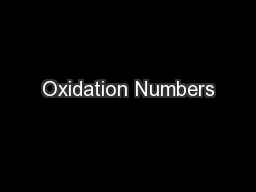

p232234 Assigning Oxidation Numbers Oxidation Number positive or negative number assigned to an atom according to a set of rules Rules for Assigning Oxidation Numbers The oxidation number of ID: 358653
Download Presentation The PPT/PDF document "Oxidation Numbers" is the property of its rightful owner. Permission is granted to download and print the materials on this web site for personal, non-commercial use only, and to display it on your personal computer provided you do not modify the materials and that you retain all copyright notices contained in the materials. By downloading content from our website, you accept the terms of this agreement.
Slide1
Oxidation Numbers
p.232-234Slide2
Assigning Oxidation Numbers
Oxidation Number
: positive or negative number assigned to an atom according to a set of
rulesSlide3
Rules for Assigning Oxidation Numbers
The oxidation number of
any free element
is 0
- Na or O
2
The oxidation number of a
monatomic ion
is equal to the charge on the ion. Some atoms have several possible oxidation numbers.
- Iron can be Fe
2+
or Fe
3+
Slide4
Rules for Assigning Oxidation Numbers
The oxidation number of each
hydrogen
atom in most of its compounds is +1,
EXCEPT
in metal hydrides (
LiH
) where it is -1.
The oxidation number of
oxygen
IN A COMPOUND
is -2, EXCEPT in peroxides (H
2
O
2
) where it is -1.Slide5
Rules for Assigning Oxidation Numbers
The sum of the oxidation numbers of
ALL THE ATOMS
in a particle must equal the apparent
charge
of that particle.
SO
4
2-
, S
2
O
3
2-
, Na
2
SO
4
In compounds, the elements of Group 1, 2, and aluminum have positive oxidation #’s of +1, +2, and +3 respectively.
AlBr
3
,
CaOSlide6
Now you try some!
Find the oxidation numbers of
iodine
in HIO4
, HIO
3
, HIO,
HI
Section Review p. 235 #1 a-
iSlide7
Oxidation-number Changes in Chemical Reactions
If the oxidation number increases for an atom
Oxidation has occurred
If the oxidation number decreases for an atom
Reduction has occurred
2AgNO
3
(
aq
) + Cu(s)
Cu(NO
3
)
2
(aq) + 2Ag(s)What is being oxidized? What is being reduced?
+1 +5 –2 0 +2 +5 –2 0Slide8
Now you try some!
Use the changes in oxidation numbers to identify which atoms are oxidized, and which atoms are reduced:
2H
2
(g) + O
2
(g)
2H
2
O (l)
2KNO
3
(s) 2KNO
2
(s) + O2 (g) NH
4
NO
3
(s) N
2
(g) + 2H
2
O (g)
(
HINT
: consider each N separately)
PbO
2
(
aq
) + 4HI (
aq
) I
2
(
aq
) + PbI
2
(s) + 2H
2
O (l)